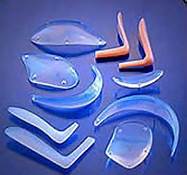
Complications with facial implants generally fall into several categories including implant selection, placement technique, nerve injuries and infection. Almost all of these potential problems can be minimized by specific techniques, although not always completely avoidable.
IMPLANT SELECTION
With such a large number of different facial implant styles and sizes, it is no wonder that an incorrect implant choice can be made. This can occur in both the style and size of the implant. Despite knowing the exact measurements and shape of an implant, there is no way to guarantee what the final influence on the external shape of the face will be. This has a lot to do with the quality of the overlying tissues, the thickness of the skin, fat and muscle layers, as well as the shape of the underlying bone. In terms of facial predictability amongst the three most commonly used implants, chin implants are better than cheek and jaw angle implants.
Cheek and jaw angle implants have a significant rate of revision and dissatisfaction due to selection issues. The three-dimensional shape of the cheek area requires a very careful analysis and discussion with the patient as to exactly what they want to achieve. The adjoining shape of the orbit and maxilla also influences how cheek augmentation may look. The cheek is clearly the most ‘artsy’ of all facial implants as there is no precise measurement method of such a curved bony area. Jaw angle implants must consider the width and height of the angle area to avoid giving someone just a wider lower face. Many patients need vertical lengthening as well as increased width and not every jaw angle implant style is designed to make that change.
DISPLACEMENT AND ASYMMETRY
Implants can shift around after surgery as the pocket dissected to place them is always greater than the size of the implant itself. While certain implant materials do slide on the bone less than others due to increased frictional resistance, complete implant stability requires screw fixation. While most surgeons don’t use them as they feel suture or no fixation at all is sufficient, the extra time and cost to use them pays dividends with decreased complications. There are no risks with using screws so there is little reason not to use them.
With the exception of the chin, most facial implants are done on both sides. (bilateral) While it seems that it should be easy to do exactly the same thing to both sides, it is not. Symmetrical implant placement is as much an art as it is a science. The implant cavities are never open to unimpeded view and can not usually be seen at the same time. Landmarks from the surrounding anatomy must be used but not every patient has perfectly symmetric anatomy either. Surgeons are usually one-handed and often work from just one side of the patient. This can create unintentional distortions in the perception of implant positioning.
Cheek implants have the highest rate of implant asymmetry due to the thinner tissues of the cheek as opposed to the chin or jaw angles. Great attention must be paid to how the implants line up along the bone using landmarks of the adjoin nerve and the lower teeth.
NUMBNESS
While every patient will have some temporary numbness of the overlying skin under which it is placed, cheek and chin implant can cause nerve distribution problems. The infraorbital nerve of the cheek and the mental nerve of the chin can be injured during dissection (very uncommon) or from impingement of the implant on the nerve as it exits from the bone. (most common) Prolonged numbness, and more pertinently sharp pain, beyond a few weeks after surgery should raise suspicion of impingement. Early intervention and implant repositioning and/or trimming is needed to prevent permanent numbness and pain. The best way to avoid nerve impingement with an implant is to see the nerve and where the implant edges. Screwing the implant in will also prevent it from shifting over and touching the nerve as well.
INFECTION
While rare, infection with facial implants can occur. It does seem to occur more commonly with porous implant materials than smooth silicone in my experience. To decrease the risk of infection, the use of antibiotics is done intravenously, the implant soaked in a solution of it, and oral antibiotics are used afterwards. But I think the most important step is the use of sizers during surgery. These are used to judge the pocket and size of the implant, thus the final implant can go from package into the implant pocket directly with minimal handling. (one-time pass)
When infection occurs, the standard treatment is to remove the implant and let the infection resolve. But this is not always necessary and the implant procedure can sometimes be salvaged. The implant can be removed, the pocket irrigated and a new implant can be simultaneously placed. The risk for recurrent infection is higher with this approach but I have seen it work numerous times. The key is to get out the inoculated implant as that is the source of the infection.
BONE EROSION
I mention it as a complication but only as a sidebar. I have read about it for many years, and seen numerous patients, who had severe ‘bone erosion’. (always in the chin with very highly positioned implants which have been in a long time) Many facial implant patients ask beforehand about this risk. Largely, I think it is a non-entity. Implants, particularly chin implants, can settle into the bone a few millimeters which is a passive pressure-relief phenomenon. But implants eating into the bone is a myth not a reality.
Dr. Barry Eppley
Indianapolis, Indiana


